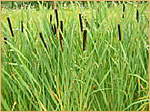|
|
 |
 |
|
|
 |
 |
 |
|
Member of the Wildlife & Environment
Society of South Africa Western Cape Region
|
 |
|
|
|
| Eco Bites |
 |
| The Typha
Take-over |
 |
|
Bulrushes are taking over. In
many of the reedbed areas around
Rietvlei bulrushes are
displacing other wetland plants,
and in the Dolphin Beach ponds
the water area is gradually
disappearing under bulrush
growth. |
|
What is this reed and where does it come from? |
 |
|
There are 11 species of Typha world-wide, most
occurring in the Northern hemisphere; in addition
there are several hybrid species. Typha latifolia
is the most common species and occurs naturally on
all continents except South America and Australia,
but it has now been introduced there. Typha capensis is common in southern
Africa, and is the local species found in many of
our wetlands. The reed has many common names in
different parts of the world, we know it as bulrush,
cattail, or by the British name reed-mace. |
|
Although often a nuisance, they
are extremely efficient in
removing nutrients from water
and are thus very effective
filters. Bulrushes grow in
wetlands, lakes, river courses,
estuarine habitats and even in
marshy coastal habitats which is
predominantly fresh water. When
conditions favour Typha they
form dense monocultures,
spreading rapidly by vegetative
reproduction forming thick mats
of rhizomes and plant litter.
This impacts on other species by
changing the habitat and forcing
other plants out; they can
rapidly close open water giving
other plants few opportunities
to establish. Typha seeds are
dispersed by winds, in water, on
the feet of birds and livestock,
or by humans and machinery. |
 |
|
Uses of Typha |
|
However, Typha is also a very
useful plant and is used for
many things. It is used as
thatch for roofing; woven into
mats, chairs, hats, etc; it is a
source of fibre for rayon and a
greenish brown paper; it is used
as torches and tinder for making
fires; the flower clusters are
used for stuffing pillows and
mattresses, and for insulation,
dressing wounds, and lining
diapers. Typha stands provide
important food and cover for
wildlife and birds, establishing
habitat for many waterfowl. Many
parts of the plant is also
edible for human consumption and
are an important source of
protein in many parts of the
world; rhizomes are dried and
ground into flour or eaten as
cooked vegetables; young stems
are eaten raw or cooked; and the
pollen is used in baking. |
|
Because of its very effective
water filtering properties,
Typha is widely used in
artificial ponds to filter
effluent and stormwater runoff
in many parts of the world,
including Cape Town. |
 |
|
Controlling Typha |
|
Controlling excessive Typha
growth is extremely difficult
and can be quite costly,
particularly in natural systems.
Various methods have been tried
and tested all over the world,
but there is no easy way to
control the plant. |
|
Herbicides can be effective when
applied while the plant is
flowering, but the disadvantage
is that the decaying plant
material accumulates and results
in hypertrophic conditions, this
plant material also provides a
good substrate for regrowth of
Typha. Some herbicides may also
have negative effects on other
plant and animal life in the
system. |
|
Mechanical removal is difficult
because of the depth and volume
of the rhizomes, but it can be
effective in reducing the size
of infestations. Manual removal
works best on small seedlings
when they can be easily pulled
out of the damp soil. |
|
The best way to control Typha
seems to be using fire and
physical cutting in conjunction
with flooding. If the reeds are
burnt and/or cut when water
levels are low, and then
flooded, growth is considerably
inhibited. An effective control
can be achieved by a combination
of mechanical and hand cutting
at the end of the growing season
and when water levels are low,
two clippings about a week or
two apart will achieve best
results, but then the cut area
must be submerged as soon after
in at least 8 to 10 cm of water
when water levels rise again. |
|
Something will have to be done
about the Typha growth in
certain areas of Rietvlei, but
any control operation will be
costly and time-consuming. Using
fire will help a great deal, but
there are inherent dangers that
must be considered. Access to
the affected areas for cutting
or mechanical control is not
always easy and further
complicates control operations. |
 |
|
Compiled by Niel van Wyk from
various sources. |
|
 |
|
|
 |
|
|